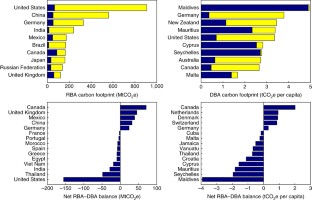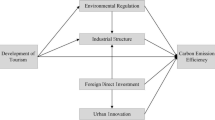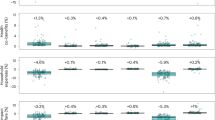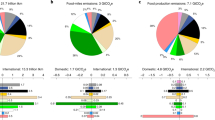Abstract
Tourism contributes significantly to global gross domestic product, and is forecast to grow at an annual 4%, thus outpacing many other economic sectors. However, global carbon emissions related to tourism are currently not well quantified. Here, we quantify tourism-related global carbon flows between 160 countries, and their carbon footprints under origin and destination accounting perspectives. We find that, between 2009 and 2013, tourism’s global carbon footprint has increased from 3.9 to 4.5 GtCO2e, four times more than previously estimated, accounting for about 8% of global greenhouse gas emissions. Transport, shopping and food are significant contributors. The majority of this footprint is exerted by and in high-income countries. The rapid increase in tourism demand is effectively outstripping the decarbonization of tourism-related technology. We project that, due to its high carbon intensity and continuing growth, tourism will constitute a growing part of the world’s greenhouse gas emissions.
This is a preview of subscription content, access via your institution
Access options
Access Nature and 54 other Nature Portfolio journals
Get Nature+, our best-value online-access subscription
$29.99 / 30 days
cancel any time
Subscribe to this journal
Receive 12 print issues and online access
$209.00 per year
only $17.42 per issue
Buy this article
- Purchase on Springer Link
- Instant access to full article PDF
Prices may be subject to local taxes which are calculated during checkout





Similar content being viewed by others
Change history
23 May 2018
In the version of this Article originally published, in the penultimate paragraph of the section “Gas species and supply chains”, in the sentence “In this assessment, the contribution of air travel emissions amounts to 20% (0.9 GtCO2e) of tourism’s global carbon footprint...” the values should have read “12% (0.55 GtCO2e)”; this error has now been corrected, and Supplementary Table 9 has been amended to clarify this change.
References
Travel & Tourism: Economic Impact 2017 (World Travel & Tourism Council, 2017); https://www.wttc.org/-/media/files/reports/economic-impact-research/regions-2017/world2017.pdf
UNWTO Tourism Highlights 2016 Edition (World Tourism Organization, 2016); http://www.e-unwto.org/doi/pdf/10.18111/9789284418145
Gössling, S. Global environmental consequences of tourism. Glob. Environ. Change 12, 283–302 (2002).
Scott, D., Gössling, S. & Hall, C. M. International tourism and climate change. WIREs Clim. Change 3, 213–232 (2012).
Puig, R. et al. Inventory analysis and carbon footprint of coastland-hotel services: a Spanish case study. Sci. Total Environ. 595, 244–254 (2017).
El Hanandeh, A. Quantifying the carbon footprint of religious tourism: the case of Hajj. J. Clean. Prod. 52, 53–60 (2013).
Pereira, R. P. T., Ribeiro, G. M. & Filimonau, V. The carbon footprint appraisal of local visitor travel in Brazil: a case of the Rio de Janeiro–São Paulo itinerary. J. Clean. Prod. 141, 256–266 (2017).
Munday, M., Turner, K. & Jones, C. Accounting for the carbon associated with regional tourism consumption. Tour. Manag. 36, 35–44 (2013).
Sun, Y.-Y. A framework to account for the tourism carbon footprint at island destinations. Tour. Manage. 45, 16–27 (2014).
Cadarso, M. Á., Gómez, N., López, L. A. & Tobarra, M. A. Calculating tourism’s carbon footprint: measuring the impact of investments. J. Clean. Prod. 111, 529–537 (2016).
Cadarso, M.-Á., Gómez, N., López, L.-A., TobarraM.-Á. & Zafrilla, J.-E. Quantifying Spanish tourism’s carbon footprint: the contributions of residents and visitors: a longitudinal study. J. Sustain. Tour. 23, 922–946 (2015).
Becken, S. & Patterson, M. Measuring national carbon dioxide emissions from tourism as a key step towards achieving sustainable tourism. J. Sustain. Tour. 14, 323–338 (2006).
Dwyer, L., Forsyth, P., Spurr, R. & Hoque, S. Estimating the carbon footprint of Australian tourism. J. Sustain. Tour. 18, 355–376 (2010).
Sharp, H., Grundius, J. & Heinonen, J. Carbon footprint of inbound tourism to Iceland: a consumption-based life-cycle assessment including direct and indirect emissions. Sustainability 8, 1147 (2016).
Luo, F., Becken, S. & Zhong, Y. Changing travel patterns in China and ‘carbon footprint’ implications for a domestic tourist destination. Tour. Manag. 65, 1–13 (2018).
Climate Change and Tourism—Responding to Global Challenges (World Tourist Organisation, United Nations Environment Programme, World Meteorological Organisation, 2008); http://sdt.unwto.org/sites/all/files/docpdf/climate2008.pdf
Peeters, P. & Dubois, G. Tourism travel under climate change mitigation constraints. J. Transp. Geogr. 18, 447–457 (2010).
Gössling, S. & Peeters, P. Assessing tourism’s global environmental impact 1900–2050. J. Sustain. Tour. 23, 639–659 (2015).
Kander, A., Jiborn, M., Moran, D. D. & Wiedmann, T. O. National greenhouse-gas accounting for effective climate policy on international trade. Nat. Clim. Change 5, 431–435 (2015).
ICAO Environmental Report 2016—Aviation and Climate Change (International Civil Aviation Organization, 2016).
Lee, D. S. et al. Transport impacts on atmosphere and climate: aviation. Atmos. Environ. 44, 4678–4734 (2010).
Perch-Nielsen, S., Sesartic, A. & Stucki, M. The greenhouse gas intensity of the tourism sector: the case of Switzerland. Environ. Sci. Policy 13, 131–140 (2010).
Peters, G., Minx, J., Weber, C. & Edenhofer, O. Growth in emission transfers via international trade from 1990 to 2008. Proc. Natl Acad. Sci. USA 108, 8903–8908 (2011).
Malik, A., Lan, J. & Lenzen, M. Trends in global greenhouse gas emissions from 1990 to 2010. Environ. Sci. Technol. 50, 4722–4730 (2016).
GDP Per Capita, Current Prices (International Monetary Fund, 2017); http://www.imf.org/external/datamapper/NGDPDPC@WEO/OEMDC/ADVEC/WEOWORLD
Annual Energy Outlook 2017 With Projections to 2050 (US Energy Information Administration, 2017); https://www.eia.gov/outlooks/aeo/pdf/0383(2017).pdf
OECD Environmental Outlook to 2050 (OECD Environment Directorate, PBL Netherlands Environmental Assessment Agency, 2011); https://www.oecd.org/env/cc/49082173.pdf
Wier, M., Lenzen, M., Munksgaard, J. & Smed, S. Effects of household consumption patterns on CO2 requirements. Econ. Syst. Res. 13, 259–274 (2001).
Lenzen, M. et al. A comparative multivariate analysis of household energy requirements in Australia, Brazil, Denmark, India and Japan. Energy 31, 181–207 (2006).
Lenzen, M., Dey, C. & Foran, B. Energy requirements of Sydney households. Ecol. Econ. 49, 375–399 (2004).
Garin-Munoz, T. & Amaral, T. P. An econometric model for international tourism flows to Spain. Appl. Econ. Lett. 7, 525–529 (2000).
Lim, C., Min, J. C. H. & McAleer, M. Modelling income effects on long and short haul international travel from Japan. Tour. Manage. 29, 1099–1109 (2008).
Song, H. & Wong, K. K. Tourism demand modeling: a time-varying parameter approach. J. Travel Res. 42, 57–64 (2003).
Cohen, C. A. M. J., Lenzen, M. & Schaeffer, R. Energy requirements of households in Brazil. Energy Policy 55, 555–562 (2005).
Mishra, S. S. & Bansal, V. Role of source–destination proximity in international inbound tourist arrival: empirical evidences from India. Asia Pac. J. Tour. Res. 22, 540–553 (2017).
Wong, I. A., Fong, L. H. N. & LawR. A longitudinal multilevel model of tourist outbound travel behavior and the dual-cycle model. J. Travel Res. 55, 957–970 (2016).
Dubois, G. & Ceron, J. P. Tourism/leisure greenhouse gas emissions forecasts for 2050: factors for change in France. J. Sustain. Tour. 14, 172–191 (2006).
Filimonau, V., Dickinson, J. & Robbins, D. The carbon impact of short-haul tourism: a case study of UK travel to southern France using life cycle analysis. J. Clean. Prod. 64, 628–638 (2014).
Gössling, S., Scott, D. & Hall, C. M. Inter-market variability in CO2 emission-intensities in tourism: implications for destination marketing and carbon management. Tour. Manage. 46, 203–212 (2015).
Gössling, S. et al. The eco-efficiency of tourism. Ecol. Econ. 54, 417–434 (2005).
Hatfield-Dodds, S. et al. Australia is ‘free to choose’ economic growth and falling environmental pressures. Nature 527, 49–53 (2015).
Lenzen, M., Malik, A. & Foran, B. How challenging is decoupling for Australia?. J. Clean. Prod. 139, 796–798 (2016).
Gössling., S. Sustainable tourism development in developing countries: some aspects of energy use. J. Sustain. Tour. 8, 410–425 (2000).
Székely, T. Hungary plans ‘major touristic developments’ to double income from foreign tourism. Hungary Today (13 February 2017); http://hungarytoday.hu/news/hungary-plans-several-major-touristic-developments-double-income-foreign-tourism-45636
Nepal unveils plans to double tourist arrival. Nepal24Hours (12 December 2012); http://www.nepal24hours.com/nepal-unveils-plans-to-double-tourist-arrival
Murai, S. Japan doubles overseas tourist target for 2020. Japan Times (30 March 2016); https://www.japantimes.co.jp/news/2016/03/30/national/japan-doubles-overseas-tourist-target-2020/#.Wh_XplWWapo
McElroy, J. L. Small island tourist economies across the life cycle. Asia. Pac. Viewp. 47, 61–77 (2006).
Lenzen, M. Sustainable island businesses: a case study of Norfolk Island. J. Clean. Prod. 16, 2018–2035 (2008).
de Bruijn, K., Dirven, R., Eijgelaar, E. & Peeters, P. Travelling Large in 2013: The Carbon Footprint of Dutch Holidaymakers in 2013 and the Development Since 2002 (NHTV Breda University of Applied Sciences, 2014).
Sun, Y. -Y. Decomposition of tourism greenhouse gas emissions: revealing the dynamics between tourism economic growth, technological efficiency, and carbon emissions. Tour. Manage. 55, 326–336 (2016).
Wilkinson, P. F. Island tourism: sustainable perspectives. Ann. Tour. Res. 39, 505–506 (2012).
Tourism Statistics (World Tourism Organization, 2017); http://www.e-unwto.org/loi/unwtotfb
Lenzen, M., Kanemoto, K., Moran, D. & Geschke, A. Mapping the structure of the world economy. Environ. Sci. Technol. 46, 8374–8381 (2012).
Lenzen, M., Moran, D., Kanemoto, K. & Geschke, A. Building EORA: a global multi-region input–output database at high country and sector resolution. Econ. Syst. Res. 25, 20–49 (2013).
Leontief, W. W. & Strout, A. A. in Structural Interdependence and Economic Development (ed. Barna, T.) 119–149 (Macmillan, Basingstoke, 1963).
Oita, A. et al. Substantial nitrogen pollution embedded in international trade. Nat. Geosci. 9, 111–115 (2016).
Feng, K., Davis, S. J., Sun, L. & Hubacek, K. Drivers of the US CO2 emissions 1997–2013. Nat. Commun. 6, 7714 (2015).
Steinberger, J. K., Roberts, J. T., Peters, G. P. & Baiocchi, G. Pathways of human development and carbon emissions embodied in trade. Nat. Clim. Change 2, 81–85 (2012).
Lenzen, M. et al. International trade drives biodiversity threats in developing nations. Nature 486, 109–112 (2012).
Lin, J. et al. Global climate forcing of aerosols embodied in international trade. Nat. Geosci. 9, 790 (2016).
Dalin, C., Wada, Y., Kastner, T. & Puma, M. J. Groundwater depletion embedded in international food trade. Nature 543, 700 (2017).
Zhang, Q. et al. Transboundary health impacts of transported global air pollution and international trade. Nature 543, 705 (2017).
Travel & Tourism: Economic Impact Research Methodology (World Travel & Tourism Council, Oxford Economics, 2017); https://www.wttc.org/-/media/files/reports/economic-impact-research/2017-documents/2017_methodology-final.pdf
Leontief, W. Input–Output Economics (Oxford Univ. Press, Oxford, 1966).
Dixon, R. Inter-industry transactions and input–output analysis. Aust. Econ. Rev. 3, 327–336 (1996).
Munksgaard, J. & Pedersen, K. A. CO2 accounts for open economies: producer or consumer responsibility? Energy Policy 29, 327–334 (2001).
Kanemoto, K. & Murray, J. in The Sustainability Practitioner’s Guide to Input–Output Analysis (eds Murray, J. & Wood, R.) 167–178 (Common Ground, Champaign, 2010).
Kanemoto, K., Lenzen, M., Peters, G. P., Moran, D. & Geschke, A. Frameworks for comparing emissions associated with production, consumption and International trade. Environ. Sci. Technol. 46, 172–179 (2012).
Waugh, F. V. Inversion of the Leontief matrix by power series. Econometrica 18, 142–154 (1950).
Lenzen, M. et al. The Global MRIO Lab—charting the world economy. Econ. Syst. Res. 29, 158–186 (2017).
Systems of National Accounts (International Monetary Fund, Commission of the European Communities-Euro-Stat, Organisation for Economic Co-operation and Development, World Bank, United Nations, 1993).
TSA Data Around the World: Worldwide Summary (World Tourism Organization, 2010).
Tourism Statistics 2009–2013 (World Tourism Organization, 2009–2013).
Chasapopoulos, P., den Butter, F. A. & Mihaylov, E. Demand for tourism in Greece: a panel data analysis using the gravity model. Int. J. Tour. Policy 5, 173–191 (2014).
Morley, C., Rosselló, J. & Santana-Gallego, M. Gravity models for tourism demand: theory and use. Ann. Tour. Res. 48, 1–10 (2014).
Lloyd, S. M. & Ries, R. Characterizing, propagating, and analyzing uncertainty in life-cycle assessment: a survey of quantitative approaches. J. Indust. Ecol. 11, 161–179 (2007).
Imbeault-Tétreault, H., Jolliet, O., Deschênes, L. & Rosenbaum, R. K. Analytical propagation of uncertainty in life cycle assessment using matrix formulation. J. Indust. Ecol. 17, 485–492 (2013).
Lenzen, M. Aggregation versus disaggregation in input-output analysis of the environment. Econ. Syst. Res 23, 73–89 (2011).
Bullard, C. W. & Sebald, A. V. Effects of parametric uncertainty and technological change on input-output models. Rev. Econ. Stat. 59, 75–81 (1977).
Bullard, C. W. & Sebald, A. V. Monte Carlo sensitivity analysis of input-output models. Rev. Econ. Stat. 70, 708–712 (1988).
Nansai, K., Tohno, S. & Kasahara, M. Uncertainty of the embodied CO2 emission intensity and reliability of life cycle inventory analysis by input-output approach (in Japanese). Energy Resour. 22, (2001).
Yoshida, Y. et al. Reliability of LCI considering the uncertainties of energy consumptions in input-output analyses. Appl. Energy 73, 71–82 (2002).
Lenzen, M., Wood, R. & Wiedmann, T. Uncertainty analysis for multi-region input-output models — a case study of the UK’s carbon footprint. Econ. Syst. Res 22, 43–63 (2010).
Acknowledgements
This work was financially supported by the Australian Research Council through its Discovery Projects DP0985522 and DP130101293, the National eResearch Collaboration Tools and Resources project (NeCTAR) through its Industrial Ecology Virtual Laboratory, and the Taiwan Ministry of Science and Technology (no. 105-2410-H-006-055-MY3). The authors thank S. Juraszek for expertly managing the Global IELab’s advanced computation requirements, and C. Jarabak for help with collecting data.
Author information
Authors and Affiliations
Contributions
Y.-Y.S. and M.L. conceived and designed the experiments. M.L., Y.-Y.S., F.F., Y.-P.T., A.G. and A.M. performed the experiments. F.F., Y.-P.T., M.L. and Y.-Y.S. analysed the data. Y.-P.T., A.G., Y.-Y.S. and M.L. contributed materials/analysis tools. M.L., Y.-Y.S. and A.M. wrote the paper.
Corresponding author
Ethics declarations
Competing interests
The authors declare no competing interests.
Additional information
Publisher’s note: Springer Nature remains neutral with regard to jurisdictional claims in published maps and institutional affiliations.
Supplementary information
Supplementary Information
Supplementary Methods, Supplementary Notes, Supplementary Data, Supplementary Results, Supplementary Figures 1–13, Supplementary Tables 1–14, Supplementary Discussion and Supplementary References
Rights and permissions
About this article
Cite this article
Lenzen, M., Sun, YY., Faturay, F. et al. The carbon footprint of global tourism. Nature Clim Change 8, 522–528 (2018). https://doi.org/10.1038/s41558-018-0141-x
Received:
Accepted:
Published:
Issue Date:
DOI: https://doi.org/10.1038/s41558-018-0141-x
This article is cited by
-
Assessment of low-carbon tourism development from multi-aspect analysis: a case study of the Yellow River Basin, China
Scientific Reports (2024)
-
Advancing towards carbon-neutral events
Nature Climate Change (2024)
-
“Long COVID” and Its Impact on The Environment: Emerging Concerns and Perspectives
Environmental Management (2024)
-
Assessing the socio-economic impacts of tourism packages: a methodological proposition
The International Journal of Life Cycle Assessment (2024)
-
Green finance, renewable energy, and inbound tourism: a case study of 30 provinces in China
Economic Change and Restructuring (2024)



